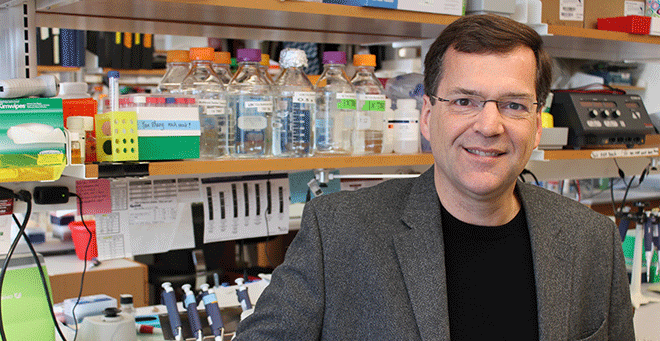Six UMass Medical School scientists are among the members of the National Institutes of Health’s Somatic Cell Genome Editing Consortium to publish a paper in Nature outlining the program’s goals to accelerate and benchmark the development of safer, more effective methods to edit the genomes of disease-relevant somatic cells in patients. Their research—comprising new genome editors, delivery technologies, methods for tracking edited cells in vivo, animal models and human biological systems—will be made available as a toolkit that other biomedical researchers can access and apply to an array of disease types and cell tissues as a means of accelerating the clinical development of new therapies for a wide range of illnesses.

“Biomedical research has now moved from reading to writing the human genome,” said Erik Sontheimer, PhD, the Pillar Chair in Biomedical Research and professor of RNA therapeutics and co-chair of the consortium’s steering committee. “The SCGE Consortium aims to develop and standardize platform technologies for gene editing that can be used by scientists across the NIH. By working together on well-integrated projects, sharing ideas and swapping technologies in real-time, the goal is for the labs of the consortium to be more than the sum of their parts.”
Supported through the NIH’s Common Fund, the consortium has been allocated about $190 million in funding over six years. This includes research being done by 72 principal investigators from 38 institutions pursuing 45 distinct projects.
UMMS is home to two such projects totaling almost $7 million. Working with Dr. Sontheimer to develop engineered guide RNAs for genome editing are: Anastasia Khvorova, PhD, the Remondi Family Chair in Biomedical Research and professor of RNA therapeutics; Jonathan K. Watts, PhD, associate professor of RNA therapeutics; and Scot A. Wolfe, PhD, professor of molecular, cell & cancer biology.
Additionally, Guangping Gao, PhD, the Penelope Booth Rockwell Professor in Biomedical Research, professor of microbiology & physiological systems, director of the Horae Gene Therapy Center and co-director of the Li Weibo Institute for Rare Diseases Research; and Wen Xue, PhD, associate professor of RNA therapeutics; are working with Daniel Anderson, PhD, associate professor of chemical engineering and health sciences & technology at the Massachusetts Institute of Technology, to develop combinatorial nonviral and viral CRISPR delivery for lung diseases.
Sontheimer and his collaborators are working on developing new chemically synthesized guide RNAs that can be used with the CRISPR/Cas system to more efficiently and effectively target cells for gene editing in the body.
Part of the elegance of the CRISPR/Cas system for making gene edits, according to Sontheimer, is that very simply, short RNA sequences can be easily interchanged to target different genes while the Cas protein responsible for cutting the genome remains the same. This allows scientists to plug new guide RNAs into the system to target different genetic locations in various cells.
However, guide RNAs aren’t ideally suited for delivery to patients. The small RNA guides tend to be unstable and they aren’t always readily absorbed by cells. Sontheimer and his group want to chemically engineer guide RNAs for the CRISPR machinery that are more efficient and stable.
“Our goal is to build a framework for modified guide RNAs that are highly functional, stable and targeted to specific tissues, and that can then be made available to the scientific community at large,” said Sontheimer.
Dr. Gao and Dr. Xue are focusing on developing combinatorial nonviral and viral CRISPR delivery for lung diseases. Funding from the c consortium will enable the development of new methods to deliver CRISPR cargos to cell types in the lung relevant to many types of lung diseases, including cystic fibrosis, said Xue.
“We are thrilled with the opportunity to work with the new consortium to improve methods that will hopefully help us mitigate unintended consequences of genome editing,” said Gao.
One of the unique attributes of the SCGE program is the requirement that every project be replicated and verified by an independent third party prior to getting funding for years four and five of the project. As part of this process, each lab must develop a protocol and a standard operating procedure for building and using its technology. By making it easier for other labs to reproduce and use this technology, the hope is that development of new clinical treatments will be accelerated, said Sontheimer.
“We are very much in the first-generation stage of these gene editing and modified guide technologies,” said Sontheimer. “But editing the cells in living patients is still a laborious and costly undertaking. Part of our efforts are intended to make these technologies accessible and scalable so you can get these potential treatments to large populations that have limited financial resources.”
Related story on UMassMed News:
UMMS scientists receive $1.6M in NIH funding to improve genome editing techniques